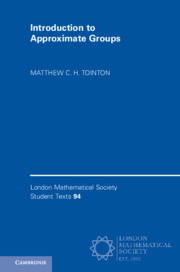Book contents
- Frontmatter
- Dedication
- Contents
- Preface
- 1 Introduction
- 2 Basic Concepts
- 3 Coset Progressions and Bohr Sets
- 4 Small Doubling in Abelian Groups
- 5 Nilpotent Groups, Commutators and Nilprogressions
- 6 Nilpotent Approximate Groups
- 7 Arbitrary Approximate Groups
- 8 Residually Nilpotent Approximate Groups
- 9 Soluble Approximate Subgroups of GLn(C)
- 10 Arbitrary Approximate Subgroups of GLn(C)
- 11 Applications to Growth in Groups
- References
- Index
9 - Soluble Approximate Subgroups of GLn(C)
Published online by Cambridge University Press: 31 October 2019
- Frontmatter
- Dedication
- Contents
- Preface
- 1 Introduction
- 2 Basic Concepts
- 3 Coset Progressions and Bohr Sets
- 4 Small Doubling in Abelian Groups
- 5 Nilpotent Groups, Commutators and Nilprogressions
- 6 Nilpotent Approximate Groups
- 7 Arbitrary Approximate Groups
- 8 Residually Nilpotent Approximate Groups
- 9 Soluble Approximate Subgroups of GLn(C)
- 10 Arbitrary Approximate Subgroups of GLn(C)
- 11 Applications to Growth in Groups
- References
- Index
Summary
We prove Breuillard and Green’s theorem that a finite approximate subgroup of a soluble complex linear group G of bounded degree is contained in a union of a few cosets of a nilpotent group of bounded step. We first treat the special case in which G is an upper-triangular group. An important ingredient is Solymosi’s sum-product theorem over the complex numbers, which we state and prove. We introduce some basic representation theory and use it to prove that a soluble complex linear group of bounded degree has a subgroup of bounded index that is conjugate to an upper-triangular group; this is a special case of a result of Mal’cev. We then use this to extend from the upper-triangular case to the general soluble case.
Keywords
Information
- Type
- Chapter
- Information
- Introduction to Approximate Groups , pp. 147 - 169Publisher: Cambridge University PressPrint publication year: 2019
